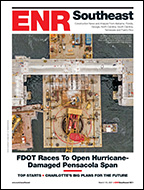
Fixing the damaged reinforced-concrete containment building at the long-idled Crystal River-3 nuclear unit in Florida will cost more than the $1.3 billion estimated by Progress Energy Florida and take longer than the utility's original 24- to 30-month estimate. Under a "worst-case scenario," repair costs could skyrocket to more than $3.4 billion and the schedule could balloon to eight years, a consultant to PEF's corporate parent said on Sept. 30.
Charlotte, N.C.-based Zapata Inc., hired by Duke Energy in March to analyze a proposal to rebuild CR-3's containment building walls, said in a regulatory report filed on Oct. 1 that the repair plan selected by PEF for further study is "feasible, but there are risks associated with the technical approach, construction methodology, scheduling and licensing."
CR-3 was taken offline in August 2009 for a planned brief outage to refuel the unit and replace its steam generator. But the following month, work to cut an opening in the unit's containment building caused a delamination, or separation, in the concrete on the circular building's periphery. In March 2011, during the final stages of returning the unit to service, a second delamination occurred.
PEF said in June 2011 that it would likely rebuild CR-3's containment building by 2014 at a cost of up to $1.3 billion. The utility considered 22 repair options, and PEF contracted Bechtel Power and URS Corp. to advance the so-called Option 10, a concept developed by Bechtel.
Under Option 10, all of the reinforced concrete in the upper 90 ft of the six-bay containment building's walls would be replaced, except for the one bay that already has been rebuilt. Also, radial anchors would be installed in the lower part of the walls to prevent future delamination. The containment building's dome would remain in place.
URS figured the project would cost $1.55 billion, including contingency costs, and would take 31 months to complete, which would push the job's completion to late 2015 or early 2016 if work were to start next spring. Zapata said that it believes URS' rebuilding plan would cost $1.49 billion, also including contingency costs, and take 35 months.
Zapata also examined completely replacing the containment building's walls and dome. That project would cost $2.44 billion and take 60 months, the consultant reported. The "worst-case scenario"—rebuilding the walls, finding the repair unsatisfactory and then building new walls and a dome—would cost $3.43 billion and take 96 months to complete.
Peer-Review Process
In May of this year, PEF selected URS "to complete the design and construction planning effort, should the decision be made to repair the facility."
Duke hired Zapata as part of its due diligence in the months prior to closing on the acquisition of Progress Energy, then PEF's parent.
After the merger closed on July 2, the North Carolina Utilities Commission (NCUC) initiated an investigation into why Progress Energy Chairman, President and CEO Bill Johnson, who had been expected to lead the combined company's day-to-day operations, was ousted almost immediately as Duke's "new" president and CEO.
Duke Chairman, President and CEO Jim Rogers told the NCUC on July 10 that a primary concern of Duke board members prior to the merger was that Johnson had poorly managed PEF's Crystal River project and, before fully examining the issue, had decided to rebuild rather than retire the unit.
Duke engaged Zapata, the consultant's report said, "to conduct an independent, third-party review of the engineering and construction plan developed by Progress and URS." Zapata's analysis, conducted this past spring and summer, raised concerns about "the repair design's ability to withstand radial tension beyond what is anticipated," as well as how the containment building's dome would respond to the work going on beneath it.
"If damage were to occur to the dome during bay repair, it may expose the project to additional licensing risk and [Nuclear Regulatory Commission, or NRC] scrutiny," Zapata said. If the dome needs repair, "it may become necessary to replace it in order to obtain NRC approval. Dome replacement carries with it very high costs and schedule implications."
Zapata also said that concrete not identified for replacement "may be subject to stresses during construction that could cause cracking or delamination." Also, conditional assessments to date "may not have revealed all the damage that exists in the structure" and that the proposed rebuilding project would face challenges due to the very tight work area.
No Final Decision Yet
Alex Glenn, PEF's incoming president, said the Zapata report "confirmed, as [PEF's] assessment had indicated, that an increase in the scope of repairs will increase the cost and extend the schedule." He said PEF has not made a final decision on whether to repair or retire CR-3. The utility would proceed with a repair option, Glenn added, "only if there is a high degree of confidence the repair can be successfully completed and licensed within the final estimated costs and schedule."
Sara Barczak, director of the high-risk energy-choices program at the Koxville, Tenn.-based Southern Alliance for Clean Energy, called CR-3 "a Humpty-Dumpty reactor" and said that, in addition to concern about mounting repair costs, SACE would have "serious safety concerns" if CR-3 is rebuilt and restarted.
"There's a big difference between technically feasible and operating safely," Barczak noting, saying her group has questions about the containment building's structural integrity and ability to contain radioactive releases.


Post a comment to this article
Report Abusive Comment